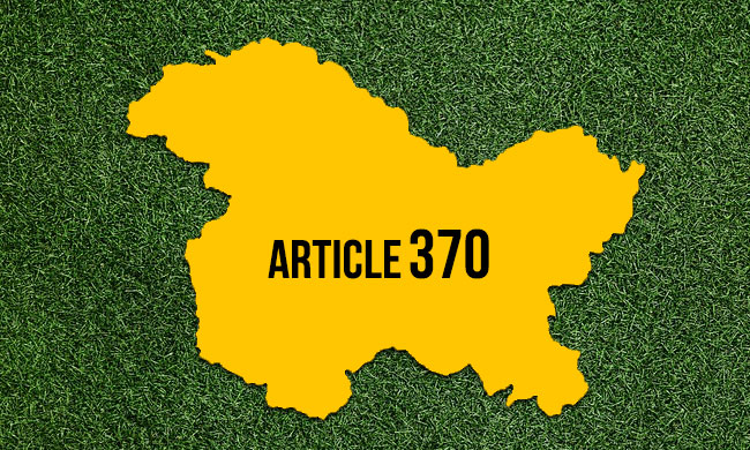Why The Government's Move On Article 370 Is Unconstitutional
Shrutanjaya Bhardwaj
6 Aug 2019 11:24 AM IST

This short piece argues that the actions taken by the President on Monday to move towards the nullification of Article 370 of the Constitution of India are unconstitutional. I will first discuss the relevant constitutional provisions, i.e. Articles 370 and 356, and then briefly describe what the Government did today. I will then explain how the Constitution has been violated.
Article 370(1) and Article 356
Broadly, Article 370(1) says two things of relevance: first, that Articles 1 and 370 shall, and that Article 238 shall not, apply to J&K; and second, that "such of the other provisions" of the Indian constitution shall apply to J&K "subject to such exceptions and modifications" as the President may specify through an Order. (More on the quoted phrases later.) Under this authority, way back in 1954, President Rajendra Prasad had issued the Constitution (Application to Jammu and Kashmir) Order, 1954. This 1954 Order provides a list of all provisions of the Indian Constitution that would apply to J&K.
Among the provisions it lists is Article 356, which provides for the imposition of what we call a "State Emergency". When a State Emergency is imposed by the President under Article 356 in respect of any state in India, two things follow:
1. The President assumes all powers and functions of the Governor of that State.
2. The Parliament assumes all powers and functions of the Legislative Assembly of that State.
This State Emergency – also called "President's Rule" – was imposed in December, 2018 and is presently in force in the State of Jammu and Kashmir.
Article 370(3)
Article 370(3) says that the President may nullify (or modify) Article 370 whenever he wants and as he wants, but this can only be done upon the recommendation of J&K's "Constituent Assembly". As this "Constituent Assembly" was dissolved in 1956, i.e. once it finished drafting the state's Constitution, it had seemed until yesterday that the procedure under Article 370(3) is now redundant and can never be followed. Yet, today's developments have rested largely on Article 370(3).
The Government's Move
We now come to what transpired today. The President issued a new Order under Article 370(1), superseding President Prasad's 1954 Order. President Kovind's Order states that all provisions of the Indian constitution shall apply to the State of Jammu and Kashmir. Further (and this is crucial), today's Order says that the words "Constituent Assembly" in Article 370(3) shall read as "Legislative Assembly". This means that the President may totally nullify or modify Article 370 whenever he wants and as he wants upon the recommendation of J&K's Legislative (instead of Constituent) Assembly.
Now, recall that a State Emergency under Article 356 is in place in J&K. As a result, the Parliament has assumed all powers and functions of the Legislative Assembly of that State. This would include the power to give the "recommendation" contemplated under Article 370(3). Therefore, given the State Emergency, the President may totally nullify or modify Article 370 – whenever he wants, as he wants – upon the Parliament's recommendation.
It is for this purpose that the Home Minister moved a resolution in the Rajya Sabha this morning. The resolution states that the House "recommends" to the President that a public notification be issued declaring that all provisions of Article 370 shall immediately cease to operate. Additionally, the resolution recommends that Article 370(1) be modified to provide that the Constitution of India shall apply on all fours to the State of Jammu and Kashmir, notwithstanding anything contained in the Indian constitution or the J&K constitution. (Reportedly, this resolution has been passed by the Rajya Sabha, and is now pending in the Lok Sabha.)
The Constitutional Error
The error lies in one line in President Kovind's Order, which seeks to replace the words "Constituent Assembly" occurring in Article 370(3) with the words "Legislative Assembly". The President could not have done this.
President Kovind's Order was issued under Article 370(1)(d). As pointed out above, this provision authorises the President to provide for the application of "such of the other provisions" of the Indian constitution, with any modifications he decides, as he specifies through the Order. The word "other" occurring in this phrase is crucial – "other" than what? A holistic reading of Article 370(1) immediately makes it clear that the word "other" implies other than Articles 1, 238 and 370 – the only provisions expressly mentioned in the same Article before this broad phrase appears.
It follows that the President, in exercise of its powers under Article 370(1), cannot touch anything within Article 370, including the words "Constituent Assembly" in Article 370(3). The President may not provide that these words shall be read as anything they are not. This power – to amend the language of Article 370(3) – rests only with the Parliament. And the Parliament may do it only by following the due procedure for constitutional amendments prescribed under Article 368 – by moving a Bill proposing a constitutional amendment and getting it passed 2/3rd of the members of each of the Lok Sabha and the Rajya Sabha.
Views are personal only.
Author is a Lawyer practicing in the Supreme Court of India.


